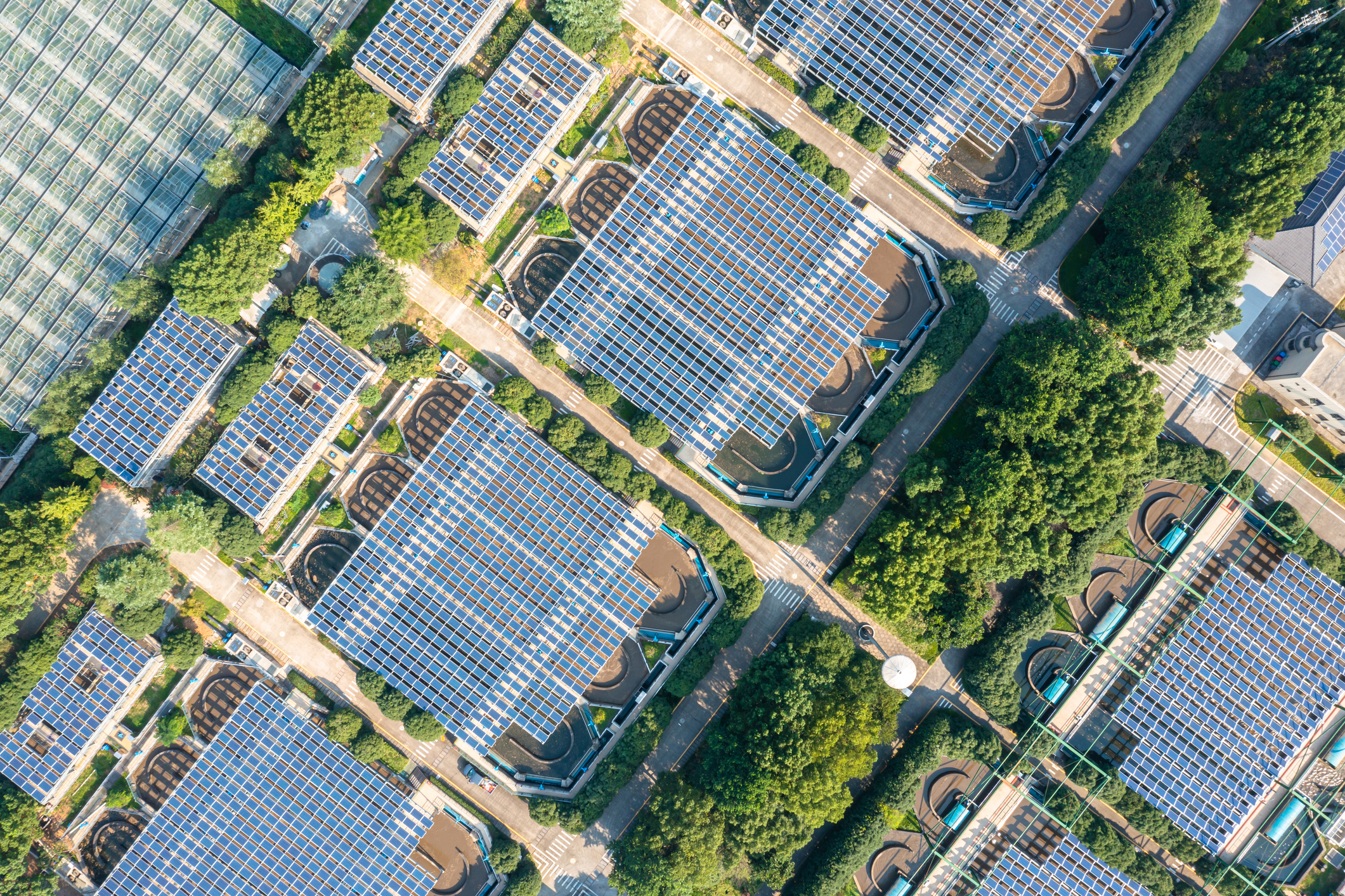China’s Carbon Emissions Are Set to Decline Years Earlier Than Expected
China’s massive rollout of renewable energy is accelerating, its investments in the sector growing so large that international climate watchdogs now expect the country’s greenhouse-gas emissions to peak years earlier than anticipated—possibly as soon as this year.
China installed 217 gigawatts worth of solar power last year alone, a 55% increase, according to new government data. That is more than 500 million solar panels and well above the total installed solar capacity of the U.S. They appeared everywhere from the deserts of Inner Mongolia to the mountains of southwest China to rooftops across the country, including on the Great Hall of the People on the edge of Tiananmen Square.
Wind-energy installation additions were 76 gigawatts last year, more than the rest of the world combined. That amounted to more than 20,000 new turbines across the country, including the world’s largest, planted on towers in the sea off China’s east coast.
The low-carbon capacity additions, which also included hydropower and nuclear, were for the first time large enough that their power output could cover the entire annual increase in Chinese electricity demand, analysts say. The dynamic suggests that coal-fired generation—which accounts for 70% of overall emissions for the world’s biggest polluter—is set to decline in the years to come, according to the Paris-based International Energy Agency and Lauri Myllyvirta , the Helsinki-based lead analyst at the Centre for Research on Energy and Clean Air.
China’s expanding renewables footprint is shaping the global response to climate change. Its companies are the leading manufacturers of clean-energy technology, from solar panels and wind turbines to electric vehicles. That is stoking concerns in the rest of the industrialized world about depending on China for their energy supplies in the future.
At the same time, China’s deployment of renewables at home is breathing new life into international climate diplomacy . Its rapid emissions growth long provided fodder for critics who said Beijing wasn’t committed to fighting climate change or supporting the Paris accord , the landmark climate agreement that calls for governments to attempt to limit warming to 1.5 degrees Celsius over preindustrial temperatures. Now, analysts and officials say Beijing’s efforts are lending momentum to the Paris process, which requires governments to draft new emissions plans every five years.
“An early peak would have a lot of symbolic value and send a signal to the world that we’ve turned a corner,” said Jan Ivar Korsbakken, a senior researcher at the Oslo-based Center for International Climate and Environmental Research.
In 2020, Chinese leader Xi Jinping pledged that the country’s emissions would begin falling before 2030 and hit net zero before 2060, part of its plan prepared under the Paris accord. He also said China would have 1,200 gigawatts of total solar- and wind-power capacity by the end of this decade. The country is six years ahead of schedule: China reached 1,050 gigawatts of wind and solar capacity at the end of 2023, and the China Electricity Council forecast last month that capacity would top 1,300 gigawatts by the end of this year.
“China’s acceleration was extraordinary,” said Fatih Birol , the executive director of the Paris-based International Energy Agency.
Chinese authorities publish regular data on energy consumption and generation but not overall greenhouse-gas emissions. Transition Zero, a U.K.-based nonprofit that uses satellite images to monitor industrial activity and emissions in China, says the official data are “broadly aligned and consistent” with theirs.
Once the peak arrives, some analysts expect an emissions plateau to follow rather than a rapid fall in the following years. That is a problem, scientists say, because the world’s major emitters must sharply cut global emissions this decade—by 43% compared with 2019—to fulfill the Paris accord.
Climate Action Tracker, a scientific consortium that evaluates governments’ emissions plans, rates China’s current policies as “highly insufficient” to meet the 1.5 degrees Celsius goal . Its latest analysis, published in November, says China’s emissions should peak by 2025. If wind and solar installations can average 300 gigawatts a year—as they did last year—China’s emissions should fall significantly by the end of the decade, the consortium says. The actions and policies of the U.S., where emissions have been falling, were graded as “insufficient.”
Still, moving China’s timeline for an overall emissions peak forward could shave off around 0.3 to 0.4 degrees Celsius of projected global warming if emissions started to decline next decade, analysts say. Emissions plans submitted to date under the Paris accord would put the world on track to warm by 2.5 degrees Celsius this century, a United Nations Environment Program report said in November.
China is still building coal-fired power plants , fueling criticism from Western officials that it is locking in carbon-dioxide emissions years into the future. Beijing has been telling Western officials that the new plants won’t be as polluting as they fear. They are replacing older, higher-emitting plants, and will run far below full capacity, used largely to maintain electric-grid stability as China generates more of its power from intermittent wind and solar. In November, China unveiled a system of capacity payments for coal-fired plants that will allow them to earn money even when they are running as backup power sources. Xi said in 2021 that China would begin to phase down its coal consumption starting in 2026.
The exact timing of China’s peak depends on factors such as economic growth and weather in the next few years, analysts say. Growth is expected to slow following China’s real-estate sector slump —unless Beijing undertakes a major new program of economic stimulus that would boost industrial emissions. Another spell of drought this summer would push the country’s coal plants to run harder to replace lost hydropower generation.
The most certain variable in the equation is the breakneck pace of China’s renewable-energy rollout, which analysts expect will continue to add 200 to 300 gigawatts of new wind and solar capacity a year. The investments in renewable energy have become a major driver of the Chinese economy. The country’s clean-energy spending totaled $890 billion last year, up 40%. Without that growth, investment in China would have been flat as the country reels from the slump in its real-estate sector, according to the Centre for Research on Energy and Clean Air.
The investments include clean-energy installations and the construction of enormous factories to produce solar panels, wind turbines, batteries and electric vehicles—turning the country into the leading manufacturer of clean tech. Its factories in those sectors now have plenty of unused capacity . The adoption of electric vehicles is happening so rapidly that analysts say peak gasoline demand in China was already reached last year.
At the United Nations COP28 climate conference in Dubai in November, Xie Zhenhua , then China’s climate envoy , said the government would calculate the year and absolute volume of the country’s emissions peak. He also said Beijing is drawing up its next emissions plan under the Paris accord.
“Our country will do as it’s said and strive to do even better,” he said. “I have faith.”
 Copyright 2020, Dow Jones & Company, Inc. All Rights Reserved Worldwide. LEARN MORE
Copyright 2020, Dow Jones & Company, Inc. All Rights Reserved Worldwide. LEARN MORE
This stylish family home combines a classic palette and finishes with a flexible floorplan
Just 55 minutes from Sydney, make this your creative getaway located in the majestic Hawkesbury region.
Impact investing is becoming more mainstream as larger, institutional asset owners drive more money into the sector, according to the nonprofit Global Impact Investing Network in New York.
In the GIIN’s State of the Market 2024 report, published late last month, researchers found that assets allocated to impact-investing strategies by repeat survey responders grew by a compound annual growth rate (CAGR) of 14% over the last five years.
These 71 responders to both the 2019 and 2024 surveys saw their total impact assets under management grow to US$249 billion this year from US$129 billion five years ago.
Medium- and large-size investors were largely responsible for the strong impact returns: Medium-size investors posted a median CAGR of 11% a year over the five-year period, and large-size investors posted a median CAGR of 14% a year.
Interestingly, the CAGR of assets held by small investors dropped by a median of 14% a year.
“When we drill down behind the compound annual growth of the assets that are being allocated to impact investing, it’s largely those larger investors that are actually driving it,” says Dean Hand, the GIIN’s chief research officer.
Overall, the GIIN surveyed 305 investors with a combined US$490 billion under management from 39 countries. Nearly three-quarters of the responders were investment managers, while 10% were foundations, and 3% were family offices. Development finance institutions, institutional asset owners, and companies represented most of the rest.
The majority of impact strategies are executed through private-equity, but public debt and equity have been the fastest-growing asset classes over the past five years, the report said. Public debt is growing at a CAGR of 32%, and public equity is growing at a CAGR of 19%. That compares to a CAGR of 17% for private equity and 7% for private debt.
According to the GIIN, the rise in public impact assets is being driven by larger investors, likely institutions.
Private equity has traditionally served as an ideal way to execute impact strategies, as it allows investors to select vehicles specifically designed to create a positive social or environmental impact by, for example, providing loans to smallholder farmers in Africa or by supporting fledging renewable energy technologies.
Future Returns: Preqin expects managers to rely on family offices, private banks, and individual investors for growth in the next six years
But today, institutional investors are looking across their portfolios—encompassing both private and public assets—to achieve their impact goals.
“Institutional asset owners are saying, ‘In the interests of our ultimate beneficiaries, we probably need to start driving these strategies across our assets,’” Hand says. Instead of carving out a dedicated impact strategy, these investors are taking “a holistic portfolio approach.”
An institutional manager may want to address issues such as climate change, healthcare costs, and local economic growth so it can support a better quality of life for its beneficiaries.
To achieve these goals, the manager could invest across a range of private debt, private equity, and real estate.
But the public markets offer opportunities, too. Using public debt, a manager could, for example, invest in green bonds, regional bank bonds, or healthcare social bonds. In public equity, it could invest in green-power storage technologies, minority-focused real-estate trusts, and in pharmaceutical and medical-care company stocks with the aim of influencing them to lower the costs of care, according to an example the GIIN lays out in a separate report on institutional strategies.
Influencing companies to act in the best interests of society and the environment is increasingly being done through such shareholder advocacy, either directly through ownership in individual stocks or through fund vehicles.
“They’re trying to move their portfolio companies to actually solving some of the challenges that exist,” Hand says.
Although the rate of growth in public strategies for impact is brisk, among survey respondents investments in public debt totaled only 12% of assets and just 7% in public equity. Private equity, however, grabs 43% of these investors’ assets.
Within private equity, Hand also discerns more evidence of maturity in the impact sector. That’s because more impact-oriented asset owners invest in mature and growth-stage companies, which are favored by larger asset owners that have more substantial assets to put to work.
The GIIN State of the Market report also found that impact asset owners are largely happy with both the financial performance and impact results of their holdings.
About three-quarters of those surveyed were seeking risk-adjusted, market-rate returns, although foundations were an exception as 68% sought below-market returns, the report said. Overall, 86% reported their investments were performing in line or above their expectations—even when their targets were not met—and 90% said the same for their impact returns.
Private-equity posted the strongest results, returning 17% on average, although that was less than the 19% targeted return. By contrast, public equity returned 11%, above a 10% target.
The fact some asset classes over performed and others underperformed, shows that “normal economic forces are at play in the market,” Hand says.
Although investors are satisfied with their impact performance, they are still dealing with a fragmented approach for measuring it, the report said. “Despite this, over two-thirds of investors are incorporating impact criteria into their investment governance documents, signalling a significant shift toward formalising impact considerations in decision-making processes,” it said.
Also, more investors are getting third-party verification of their results, which strengthens their accountability in the market.
“The satisfaction with performance is nice to see,” Hand says. “But we do need to see more about what’s happening in terms of investors being able to actually track both the impact performance in real terms as well as the financial performance in real terms.”
This stylish family home combines a classic palette and finishes with a flexible floorplan
Just 55 minutes from Sydney, make this your creative getaway located in the majestic Hawkesbury region.






















